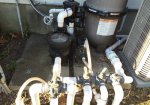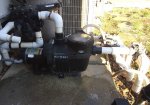Hi forum-
I'm going to be replacing my existing Hayward Northstar pump with a new EcoStar model. Currently I have a Jandy Aqualink RS6 control system, but will some time in the hopefully-not-too-distant-future be upgrading that to a new Hayward controller that can control the pump speed, but initially I would like to get the pump swapped out and the EcoStar running with the Jandy controller.
A few questions on this process, as I've been reading the manual a bit to prepare:
1) The EcoStar manual states that:
2) How does one determine the correct RPM / flow rate settings on a variable speed pump? The manual has a chart for maximum flow rate for a given pipe size, but the settings appear to be in RPMs. The AquaRite manual (currently controlling the salt cell) talks about minimum flow, but doesn't give a number. There's a chart at the beginning showing Flow Rate (gpm) vs. Head Loss (FtH20) - but I'm not sure how to interpret it.
Thanks in advance...
I'm going to be replacing my existing Hayward Northstar pump with a new EcoStar model. Currently I have a Jandy Aqualink RS6 control system, but will some time in the hopefully-not-too-distant-future be upgrading that to a new Hayward controller that can control the pump speed, but initially I would like to get the pump swapped out and the EcoStar running with the Jandy controller.
A few questions on this process, as I've been reading the manual a bit to prepare:
1) The EcoStar manual states that:
If the EcoStar pump is being used to replace an existing pump that was controlled by a separate mechanical
time clock, the EcoStar pump should be connected directly to the line power supply, bypassing the time clock.
The time clock can then be used to power other equipment (such as a heater, heat pump, or booster pump) that
requires the filter pump to be operating when used. If the time clock is used in this manner, it should be set to
power the equipment during a time cycle when the EcoStar pump is operating at an appropriate flow rate to
operate the other equipment, as defined by the timers set in the Timer Menu. See section 6.7
... and this concerns me because my controller is currently also providing power to the pool heater and salt cell only when power is applied to the pump, which makes sense to me. If I change this and hard-wire the new EcoStar, the controller will not know when it's turned on, and could potentially turn on the heater and/or salt cell when the pump is not on. The manual states that you should make sure that you don't program any of those things when the pump is off / at the minimum flow rate (based on the pump's timer settings), but there's no system interlock to prevent it. My big concern is that the controller loses the current time whenever we have a power glitch - which doesn't happen often but can happen. In that case it might wake up with the wrong time, and turn on the heater and saltgen when the pump is off, which sounds bad to me. Any guidance here?time clock, the EcoStar pump should be connected directly to the line power supply, bypassing the time clock.
The time clock can then be used to power other equipment (such as a heater, heat pump, or booster pump) that
requires the filter pump to be operating when used. If the time clock is used in this manner, it should be set to
power the equipment during a time cycle when the EcoStar pump is operating at an appropriate flow rate to
operate the other equipment, as defined by the timers set in the Timer Menu. See section 6.7
2) How does one determine the correct RPM / flow rate settings on a variable speed pump? The manual has a chart for maximum flow rate for a given pipe size, but the settings appear to be in RPMs. The AquaRite manual (currently controlling the salt cell) talks about minimum flow, but doesn't give a number. There's a chart at the beginning showing Flow Rate (gpm) vs. Head Loss (FtH20) - but I'm not sure how to interpret it.
Thanks in advance...



